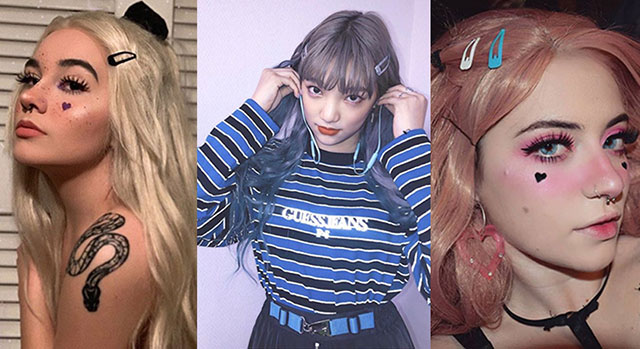
[dropcap]T[/dropcap]he e-boy and the e-girl – one of the newest subcultures that has manifested on the internet. Different from the subcultures of punks, mods and goths of the past, it’s rare that you’ll see the e-boy/e-girl in the flesh. Taking their e from electronic, the e-boy and e-girl congregate primarily online.
It is a subculture that exists for the most part in its members’ bedrooms. Influenced by anime and cosplay, the e-boy and e-girl are costumes to be worn, photographed/videoed and then put online.
Typically, the e-girl will have heavy winged eyeliner, blush and clips in their dyed colourful or black hair. The aesthetic is almost childlike alluding to DDLG (Daddy Dom Little Girl kink) aspects within the subculture. This aspect is not surprising in a generation where “I’m baby” and pretty much anything else can be “daddy”. The e-boy will usually sport nineties Leonardo Dicaprio hair, chains and a stripy top under a band t-shirt. Essentially the skater boy/goth aesthetic has gotten a software update.
The term e-girl stemmed from misogynistic gamergate culture and was used to undermine female gamers online. On the other (nail-painted) hand, the e-boy originated as an extension of the fuckboy – a thirsty, good looking boy who slides into numerous girls’ DMs requesting that they be their “goth gf”.
However, Tik Tok truly gave rise to the e-boy and e-girl as they are known today. This video-sharing app has over 1.1 billion views from videos tagged #eboy and over 1.6 billion views from videos tagged #egirl. These videos vary from e-boys rolling their eyes back to a Lil Peep song to regular girls being pulled into “e-girl factories”.
The emergence of the e-boy and the e-girl has bisected Generation Z – the demographic cohort ranging from the mid 1990s-early 2000s birth years. When the barely “90s kids” were mourning the loss of their beloved Vine rewatching compilations on YouTube, Tik Tok – and with it, e-boys and e-girls – were rapidly gaining power with the help of the noughties babies. It has left a divide within the generation – those who understand what an e-boy/e-girl is and those who don’t and at this point are too afraid to ask.
However, it should not be hard to comprehend; every generation has their cliques. Yet older Gen Zs tend to hate on the alternative look of the e-boy/e-girl while simultaneously denying their own phases by hiding tagged photos of their scene fringe from 2010.
Like most subcultures, e-boy and e-girl culture provides a channel for self-expression. Although, it could be argued that posing in front of a camera for between 3 and 15 seconds qualifies as self-obsession rather than self expression. Regardless, it cannot be denied that the e-boy/e-girl is self-aware.
Their posts are rooted in irony and self-deprecation with captions such as “am I an e-boy yet” and tagging photos and videos with #cringe. It’s difficult to determine whether someone is an e-boy/e-girl, pretending to be an e-boy/e-girl or if pretending to be an e-boy/e-girl is how one becomes an e-boy/e-girl. The dynamic culture of the e-boy and e-girl only matches the rapidly changing landscape of the online medium that spawned it.
Gemma Robotham
Image Credit: Stay Hipp



